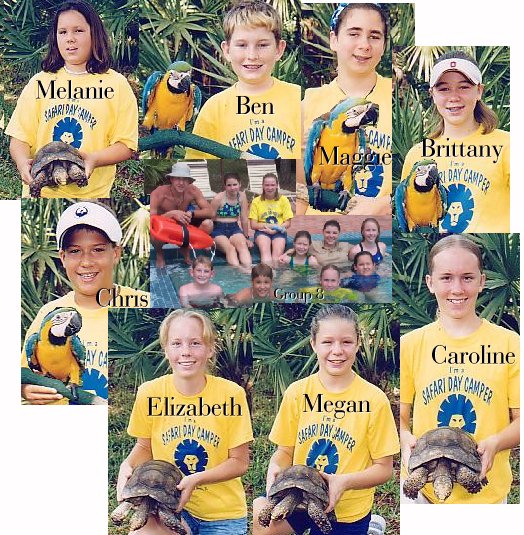













|


We met up with Brian, a keeper at Lion Country, out on the preserve by one of the herds of zebra. We learned all about zebras! In the morning, mothers and daughters often groom each other by biting off different bugs that might be bothering the other zebra. It is also a great time for them to bond. We also learned that the babies are heavy sleepers. They are often found taking a nap. When they lay down in the dirt they actually look dead! Each zebra has recognizable characteristics that set him or her apart from all the other zebras. No two zebras have the same stripe patterns, just like our fingerprints set us apart from other humans! At Lion Country, we keep track of our zebras by their stripes. With the digital camera, we have photographed every zebra that is then assigned a number. A big book is kept in the hospital to keep track of all the zebras. If one gets hurt, they take the book out to see which one it is, and then look up their medical record. It is much more reliable than ear tags because they have a tendency to fall off, especially when these aggressive animals fight. It also maintains Lion Country's "hands-off" attitude. With our binoculars we could see how each zebra really is an individual.
Later in the week we put a paper mache zebra out in the Lion section as an enrichment. It was about the same size as a baby zebra, and looked good enough to fool the lions. If you want to see some photos of the event, check here.
|

The spoonbill is an animal native to Florida. The spoonbills we have at LCS were injured in the wild and cannot be released back into the wild. Every year baby spoonbills are born here and released. We had the opportunity to go into their enclosed area and put together
their food for the day. We also cleaned off some of the cement pads where the food is set. After that was taken care of we all hunted for the best feather. We all got a nice collection. Then we headed over to the petting zoo and looked at some fertilized chicken eggs. We held the eggs up to a bright light and were actually able to see the baby chick inside. This process is called egg candeling. We actually saw some of the chicks moving!
|

We met with Andrew, who helped us prepare the diets for the Tortoises at Lion Country. We have 4 Aldabra Tortoises- 1 in the walk-thru and 3 on the preserve. In addition, we prepared the diets for the Brazilian Tapirs. Each of us got the chance to add different items to the food bowls, while Andrew explained how each day they get something different. Later in the day we headed over to Redman, the Aldabra tortoise in the walk-thru, where Linda talked to us about Redman and the species. One of the most fascinating facts we learned was how the sailors used the tortoises. They would often bring them on the ships with them for fresh eggs. When times became rough and they needed food, they could always use the tortoise for fresh meat. It was all around a great animal to have with them. And some sailor found out that if times were really desperate they could drink the urine for water. In the late 1800's, nature lovers realized that their numbers were depleting, so they created an island just for them. Their numbers flourished and are no longer as endangered. We owe them a lot of thanks because without them, the Aldabra tortoise might be extinct!
|

Jen met us at the Giraffes night pen, where we had the chance to go up and feed the giraffes. Mort, the friendliest of the giraffes, saw our bright yellow shirts and made sure to stay to enjoy all the goodies he knew the kids would be bringing. We learned all about the giraffes and other hoofstock found at Lion Country. A favorite treat was going into the night pen to look for Giraffe tail hairs. They look like and feel like wire. We all found a few hairs to take home as a keepsake. It gave us a good chance to check out the two baby giraffes that were born last month, May and Marcus. They were huge compared to us, but still pretty tiny next to their mom. They are born 6 feet tall and walking within the hour! Talk about fast learners!
|
 For South America day we had the chance to check out the preserve for a closer look. We were mainly interested in looking at the animal that come from South America like the Llamas, Brazilian Tapir, and Rhea. Then we headed to the walk-thru area for a look at some other South American animals. With the help of a scavenger hunt developed by the Education dept. we followed clues to all the different animals that are found in South America. Favorites were the chinchilla, which is native to the Andes Mountains and Gonzo, our two-toed sloth from the rain forest!
For South America day we had the chance to check out the preserve for a closer look. We were mainly interested in looking at the animal that come from South America like the Llamas, Brazilian Tapir, and Rhea. Then we headed to the walk-thru area for a look at some other South American animals. With the help of a scavenger hunt developed by the Education dept. we followed clues to all the different animals that are found in South America. Favorites were the chinchilla, which is native to the Andes Mountains and Gonzo, our two-toed sloth from the rain forest!

|
|













